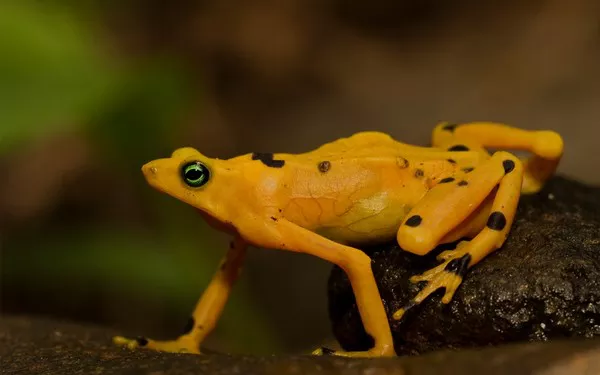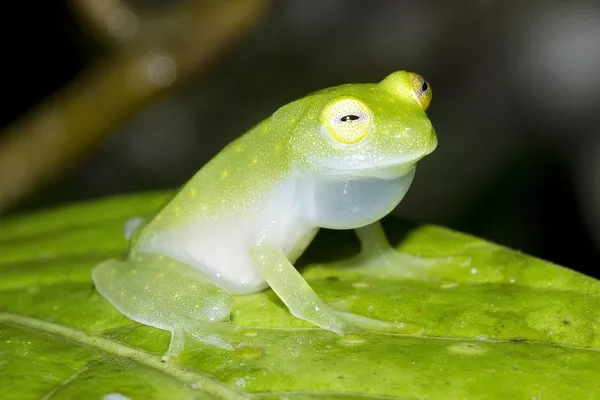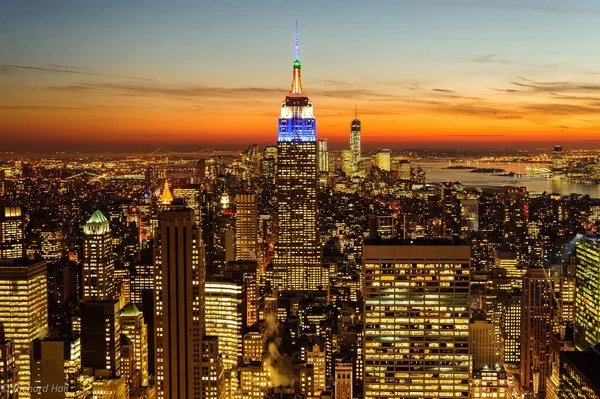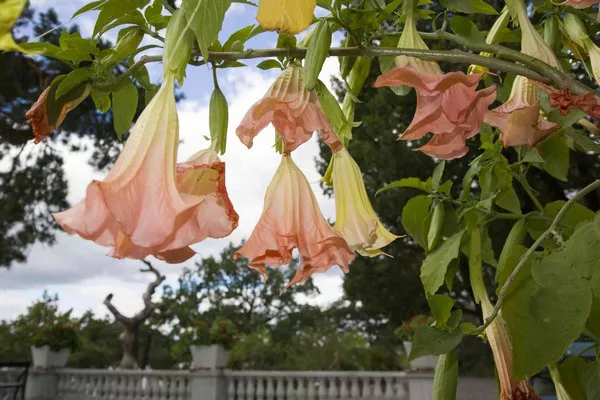In the intricate tapestry of Earth’s ecosystems, few creatures embody the juxtaposition of beauty and danger as vividly as poisonous frogs. These tiny, brightly colored amphibians captivate with their stunning hues and intricate patterns, yet harbor potent toxins capable of incapacitating predators and even posing risks to humans. In this comprehensive exploration, we delve into the captivating world of 16 beautiful but deadly poisonous frogs, unraveling their intricate biology, vibrant appearances, and the crucial roles they play in their respective habitats.
16 Beautiful but Deadly Poisonous Frogs
1. Golden Poison Frog (Phyllobates terribilis):
Description: Renowned as one of the most toxic amphibians on the planet, the Golden Poison Frog stands out with its radiant golden hue. Native to the rainforests of Colombia, this species’ skin harbors batrachotoxin, a potent neurotoxin.
Habitat and Behavior: Golden Poison Frogs inhabit humid rainforest habitats, primarily residing on the forest floor. Their toxicity serves as a defense mechanism against predators, ranging from snakes to birds.
Conservation Status: Due to habitat destruction and illegal pet trade, the Golden Poison Frog faces significant conservation challenges, warranting conservation efforts to safeguard its existence.
2. Dyeing Poison Frog (Dendrobates tinctorius):
Description: Sporting a kaleidoscope of vibrant colors ranging from azure blue to fiery orange, the Dyeing Poison Frog adorns the rainforests of South America. Its intricate patterns serve as a warning to potential predators.
Habitat and Behavior: These frogs dwell amidst the dense foliage of tropical rainforests, displaying territorial behaviors to defend their territories. Their toxicity arises from alkaloid compounds present in their skin glands.
Conservation Status: While not currently facing imminent threats, habitat loss due to deforestation poses long-term risks to the Dyeing Poison Frog’s survival.
3. Blue Poison Dart Frog (Dendrobates azureus):
Description: With its stunning azure blue skin contrasted by striking black patterns, the Blue Poison Dart Frog captivates onlookers in the rainforests of Suriname. Each frog’s pattern is unique, akin to a living work of art.
Habitat and Behavior: These frogs inhabit tropical rainforests, favoring areas near streams and water bodies. Their toxicity, attributed to batrachotoxin, serves as a defense mechanism against predators.
Conservation Status: While currently categorized as near-threatened, habitat loss and collection for the pet trade threaten the long-term survival of the Blue Poison Dart Frog.
4. Strawberry Poison Dart Frog (Oophaga pumilio):
Description: Resembling a ripe strawberry with its vibrant red hue adorned by contrasting blue limbs, the Strawberry Poison Dart Frog inhabits the rainforests of Central America. Its appearance serves as a visual deterrent to predators.
Habitat and Behavior: These frogs inhabit the leaf litter and low vegetation of tropical rainforests, exhibiting parental care behaviors such as carrying tadpoles to water bodies.
Conservation Status: While currently listed as a species of least concern, habitat degradation and collection for the pet trade necessitate conservation efforts to ensure the Strawberry Poison Dart Frog’s continued survival.
5. Green and Black Poison Dart Frog (Dendrobates auratus):
Description: Adorning the rainforests of Central and South America, the Green and Black Poison Dart Frog mesmerizes with its vibrant green and black coloration. Each individual displays a unique combination of colors and patterns.
Habitat and Behavior: These frogs inhabit humid tropical rainforests, often dwelling near streams or water bodies. Their toxicity, derived from alkaloid compounds, serves as a potent defense mechanism.
Conservation Status: While currently not facing immediate threats, habitat loss and collection for the pet trade pose long-term risks to the Green and Black Poison Dart Frog’s survival.
6. Yellow-banded Poison Dart Frog (Dendrobates leucomelas):
Description: With its striking yellow and black banding reminiscent of caution tape, the Yellow-banded Poison Dart Frog thrives in the tropical rainforests of South America. Its vibrant appearance serves as a warning to predators.
Habitat and Behavior: These frogs inhabit humid rainforest habitats, often residing near streams or water bodies. Their toxicity, attributed to alkaloid compounds, deters predators and defends territory.
Conservation Status: While currently listed as a species of least concern, habitat loss and collection for the pet trade necessitate ongoing conservation efforts to safeguard the Yellow-banded Poison Dart Frog’s populations.
7. Splash-backed Poison Frog (Dendrobates galactonotus):
Description: Named for the splash-like patterns adorning its back, the Splash-backed Poison Frog adds a splash of color to the rainforests of Brazil. Its vibrant hues serve as a visualdeterrent to predators.
Habitat and Behavior: These frogs inhabit the leaf litter and understory of tropical rainforests, exhibiting territorial behaviors to defend their territories. Their toxicity arises from alkaloid compounds present in their skin glands.
Conservation Status: While currently not facing immediate threats, habitat loss due to deforestation poses long-term risks to the Splash-backed Poison Frog’s survival.
8. Black-legged Poison Dart Frog (Phyllobates bicolor):
Description: Standing out with its striking contrast of black limbs against a vibrant body, the Black-legged Poison Dart Frog resides in the rainforests of Ecuador and Colombia. Its appearance serves as a visual warning to potential predators.
Habitat and Behavior: These frogs inhabit humid rainforest habitats, often dwelling near water bodies. Their toxicity, attributed to batrachotoxin, serves as a potent defense mechanism.
Conservation Status: While currently not facing immediate threats, habitat loss and collection for the pet trade pose long-term risks to the Black-legged Poison Dart Frog’s survival.
9. Golden Mantella (Mantella aurantiaca):
Description: Endemic to the rainforests of Madagascar, the Golden Mantella dazzles with its vibrant orange hue. Despite lacking the extensive toxicity of its neotropical counterparts, this frog still possesses mild toxic properties.
Habitat and Behavior: Golden Mantellas inhabit moist lowland rainforests, often found near streams or water bodies. Their toxicity, attributed to alkaloid compounds, serves as a deterrent to predators.
Conservation Status: Classified as endangered due to habitat loss and collection for the pet trade, the Golden Mantella faces imminent risks to its survival, warranting urgent conservation measures.
10. Harlequin Poison Frog (Oophaga histrionica):
Description: Named for its theatrical appearance reminiscent of a harlequin costume, the Harlequin Poison Frog resides in the rainforests of Colombia. Its vibrant colors and intricate patterns serve as a visual warning to predators.
Habitat and Behavior: These frogs inhabit humid rainforest habitats, often dwelling amidst leaf litter and low vegetation. Their toxicity, derived from alkaloid compounds, deters predators and defends territory.
Conservation Status: Classified as vulnerable due to habitat loss and collection for the pet trade, the Harlequin Poison Frog requires concerted conservation efforts to ensure its survival.
11. Blue Jeans Poison Dart Frog (Dendrobates pumilio):
Description: With its distinctive blue body and black spots reminiscent of denim jeans, the Blue Jeans Poison Dart Frog inhabits the rainforests of Central America. Its striking appearance serves as a visual deterrent to predators.
Habitat and Behavior: These frogs dwell amidst the leaf litter and low vegetation of tropical rainforests, exhibiting territorial behaviors to defend their territories. Their toxicity arises from alkaloid compounds present in their skin glands.
Conservation Status: While currently categorized as a species of least concern, habitat loss and collection for the pet trade pose long-term risks to the Blue Jeans Poison Dart Frog’s survival.
12. Yellow Poison Dart Frog (Dendrobates tinctorius):
Description: Distinguished by its radiant yellow hue contrasted by black patterning, the Yellow Poison Dart Frog thrives in the rainforests of South America. Its vibrant appearance serves as a visual warning to potential predators.
Habitat and Behavior: These frogs inhabit tropical rainforests, favoring areas near streams or water bodies. Their toxicity, attributed to alkaloid compounds, serves as a potent defense mechanism.
Conservation Status: While currently listed as a species of least concern, habitat loss and collection for the pet trade necessitate ongoing conservation efforts to safeguard the Yellow Poison Dart Frog’s populations.
13. Sarampiona Poison Frog (Oophaga sylvatica):
Description: Residing in the dense rainforests of Colombia, the Sarampiona Poison Frog showcases a striking combination of black and yellow coloration. Its vibrant appearance serves as a visual deterrent to predators.
Habitat and Behavior: These frogs inhabit the leaf litter and understory of tropical rainforests, exhibiting territorial behaviors to defend their territories. Their toxicity arises from alkaloid compounds present in their skin glands.
Conservation Status: While currently not facing immediate threats, habitat loss due to deforestation poses long-term risks to the Sarampiona Poison Frog’s survival.
14. Dendrobates truncatus:
Description: With its vibrant yellow-orange body adorned by contrasting black patterning, Dendrobates truncatus adds a splash of color to the rainforests of Brazil. Its appearance serves as a visual warning to potential predators.
Habitat and Behavior: These frogs inhabit humid rainforest habitats, often dwelling amidst leaf litter and low vegetation. Their toxicity, attributed to batrachotoxin, serves as a potent defense mechanism.
Conservation Status: While currently not facing immediate threats, habitat loss and collection for the pet trade pose long-term risks to Dendrobates truncatus’ survival.
15. Kokoe Poison Frog (Phyllobates aurotaenia):
Description: Named after the Kokoe people of Colombia, the Kokoe Poison Frog boasts vibrant hues of yellow, black, and orange. Its appearance serves as a visual deterrent to potential predators.
Habitat and Behavior: These frogs inhabit the leaf litter and understory of tropical rainforests, often residing near water bodies. Their toxicity, attributed to batrachotoxin, serves as a potent defense mechanism.
Conservation Status: Classified as near-threatened due to habitat loss and collection for the pet trade, the Kokoe Poison Frog requires conservation efforts to mitigate further population declines.
16. Phantasmal Poison Frog (Epipedobates tricolor):
Description: Residing in the rainforests of Ecuador and Colombia, the Phantasmal Poison Frog dazzles with its vibrant hues of orange, black, and blue. Its striking appearance serves as a visual warning to potential predators.
Habitat and Behavior: These frogs inhabit humid rainforest habitats, often dwelling amidst leaf litter and low vegetation. Their toxicity, derived from alkaloid compounds, serves as a potent defense mechanism.
Conservation Status: Classified as near-threatened due to habitat loss and collection for the pet trade, the Phantasmal Poison Frog requires conservation efforts to mitigate further population declines.
See Also: Top 10 Smartest Animals In The World
Conclusion:
The world of poisonous frogs is as mesmerizing as it is dangerous. From the radiant hues of the Golden Poison Frog to the intricate patterns of the Harlequin Poison Frog, these amphibians exemplify nature’s ability to blend beauty with peril. However, amidst their captivating appearances lies a crucial reminder of the delicate balance of ecosystems and the urgent need for conservation efforts to protect these enchanting yet vulnerable species. As we continue to explore and appreciate the wonders of the natural world, let us also strive to ensure the survival of these 16 beautiful but deadly poisonous frogs for generations to come.
You Might Be Interested In:
- 10 Fastest Water Animals In The World
- 5 Most Beautiful Tigers In The World
- Animals in The World (With Pictures!)” href=”https://www.validdownloads.com/archives/2766″ rel=”bookmark”>14 Ugliest Animals In The World (With Pictures!)




















